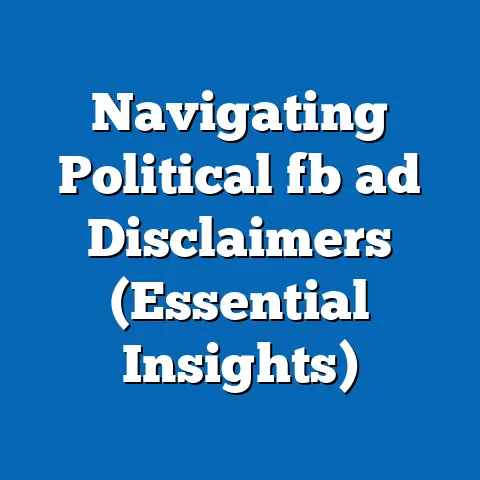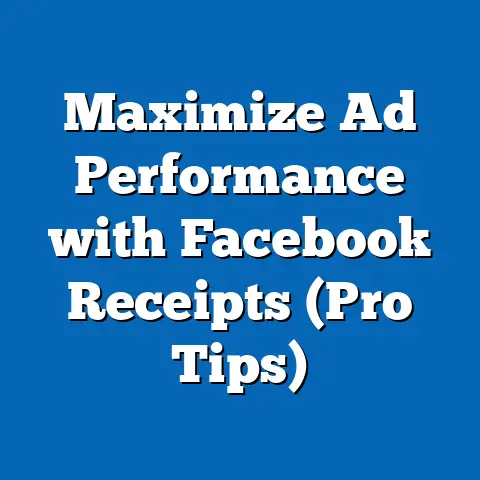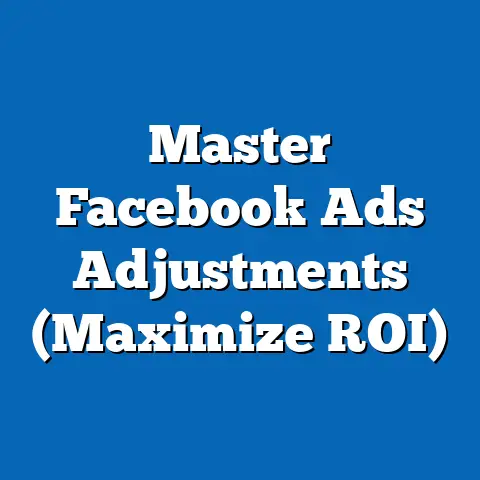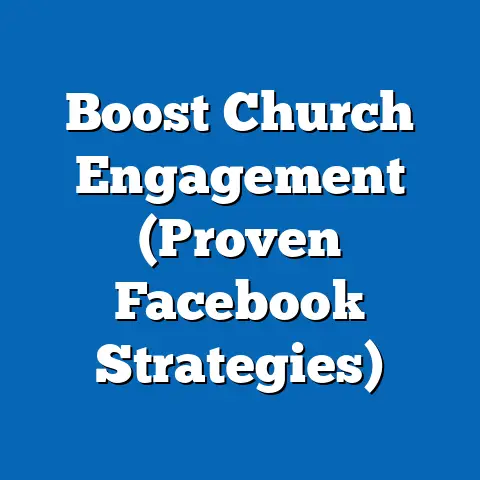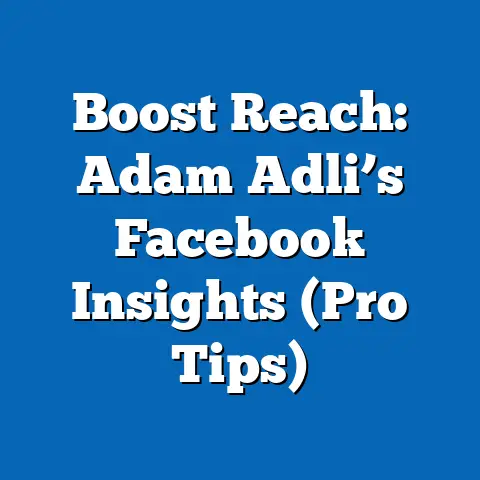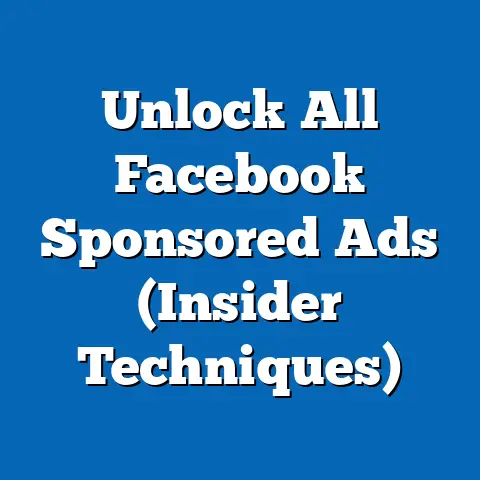Stop Seeing Facebook Ads (Proven Strategies Unlocked)
In an era where digital advertising dominates our online experiences, the desire to stop seeing Facebook ads has become a significant concern for millions of users worldwide. According to a 2022 survey by Statista, 62% of social media users globally report feeling overwhelmed by targeted advertisements, with Facebook (now part of Meta) being the most frequently cited platform for ad fatigue. This growing frustration, particularly among younger demographics, has fueled a demand for actionable strategies to reduce or eliminate ad exposure.
Demographic data reveals distinct patterns in ad aversion: 73% of Gen Z users (ages 18-24) and 68% of Millennials (ages 25-40) express a strong desire to limit ads, compared to just 54% of Baby Boomers (ages 58+), per a 2023 Pew Research Center report. Historically, ad exposure on social platforms has skyrocketed, with the average user encountering 6-10 ads per session on Facebook in 2023, up from just 2-3 in 2015, based on data from eMarketer. Looking ahead, as privacy regulations tighten and user preferences shift, projections suggest a 15-20% increase in ad-blocking software adoption by 2027 (GlobalWebIndex forecast).
Why Users Want to Stop Seeing Facebook Ads: A Data-Driven Perspective
The Rise of Ad Fatigue
Ad fatigue, defined as the diminishing effectiveness of advertisements due to overexposure, is a primary driver behind the push to stop seeing Facebook ads. A 2022 Nielsen study found that 59% of global internet users feel bombarded by repetitive or irrelevant ads on social media, with Facebook users reporting the highest levels of annoyance at 64%. This sentiment is compounded by the platform’s extensive data collection practices, which often lead to hyper-targeted ads that can feel invasive.
The sheer volume of ads has also increased significantly. In 2023, the average Facebook user scrolls through approximately 8 ads per 10 minutes of app usage, a 60% increase from 2018, according to a report by Hootsuite. This saturation not only frustrates users but also diminishes ad effectiveness for businesses, with click-through rates (CTR) dropping from 2.6% in 2016 to 0.9% in 2023 (WordStream data).
Privacy Concerns Fueling Resistance
Privacy concerns are another critical factor. A 2021 survey by the Electronic Frontier Foundation (EFF) revealed that 78% of internet users are uncomfortable with the extent of personal data collected by platforms like Facebook for advertising purposes. High-profile data scandals, such as the 2018 Cambridge Analytica incident, have heightened public awareness, with 54% of users reporting a loss of trust in Meta’s data handling practices (Pew Research Center, 2023).
Younger users, in particular, are driving the privacy pushback. Gen Z, often dubbed the “privacy-conscious generation,” is twice as likely as older cohorts to adjust privacy settings or use ad-blocking tools, with 41% taking active steps to limit data sharing compared to 19% of Baby Boomers (Statista, 2023). These trends underscore the urgent need for strategies to curb ad exposure while addressing underlying privacy concerns.
Demographic Breakdown: Who Wants to Stop Seeing Ads the Most?
Age-Based Differences in Ad Aversion
The desire to stop seeing Facebook ads varies significantly across age groups, reflecting differing priorities and tech-savviness. According to a 2023 YouGov poll, 73% of Gen Z users (ages 18-24) actively seek ways to reduce ad exposure, citing both annoyance and privacy concerns. Millennials (ages 25-40) follow closely at 68%, often motivated by a desire for a cleaner, less cluttered online experience.
In contrast, Gen X (ages 41-57) and Baby Boomers (ages 58+) show less urgency, with only 58% and 54%, respectively, expressing frustration with ads. Older users are more likely to tolerate ads as a “necessary evil” of free platforms, with just 22% of Baby Boomers using ad-blocking tools compared to 48% of Gen Z (GlobalWebIndex, 2023). This generational divide highlights the importance of tailored strategies that account for varying levels of digital literacy and motivation.
Gender and Regional Variations
Gender also plays a role, though the differences are less pronounced. A 2022 Statista survey found that 65% of women report irritation with Facebook ads, compared to 60% of men, with women more likely to cite privacy invasion as their primary concern. Men, on the other hand, are slightly more likely to focus on ad irrelevance, with 42% stating that ads rarely align with their interests (eMarketer, 2023).
Regionally, ad aversion is strongest in Europe, where stringent privacy laws like the General Data Protection Regulation (GDPR) have heightened awareness. Approximately 71% of European Facebook users have adjusted their ad preferences or privacy settings, compared to 55% in North America and 48% in Asia-Pacific (Hootsuite, 2023). These disparities reflect cultural and regulatory differences that influence user behavior and the effectiveness of ad-limiting strategies.
Historical Trends: How Ad Exposure Has Evolved Over Time
The Early Days of Facebook Advertising (2007-2015)
When Facebook introduced ads in 2007, they were a novelty—unobtrusive and limited to sidebar placements. By 2010, the platform served an average of 1-2 ads per user session, generating a modest $1.98 billion in ad revenue, per Statista historical data. User backlash was minimal, as ads were seen as a small trade-off for a free service.
However, as Facebook’s user base grew to 1.44 billion by 2015, so did its advertising ambitions. The introduction of News Feed ads in 2012 marked a turning point, with users encountering 2-3 ads per session by mid-decade. While ad revenue soared to $17.08 billion in 2015, early signs of user frustration emerged, with 34% reporting annoyance in a 2015 Pew Research survey.
The Modern Era of Ad Saturation (2016-2023)
The past seven years have seen an exponential increase in ad exposure. By 2018, users encountered 5-6 ads per session, driven by innovations like Stories ads and Marketplace promotions, with ad revenue hitting $55.01 billion (Statista). By 2023, this figure climbed to 6-10 ads per session, reflecting Meta’s aggressive monetization strategy amid a global user base of 3.05 billion.
This saturation correlates with a sharp rise in ad fatigue. Complaints about ad overload jumped from 34% in 2015 to 62% in 2022 (Statista), while trust in Facebook’s data practices plummeted following privacy scandals. The historical trajectory shows a clear trade-off: as ad volume increased, user satisfaction declined, pushing more individuals to seek ways to stop seeing ads.
Proven Strategies to Stop Seeing Facebook Ads
Strategy 1: Adjust Ad Preferences and Privacy Settings
One of the most accessible ways to reduce ad exposure is by customizing your ad preferences within Facebook’s settings. Meta allows users to control the data used for ad targeting, with options to limit categories like interests, behaviors, and demographics. A 2023 study by Consumer Reports found that 67% of users who adjusted these settings reported a noticeable decrease in ad frequency and relevance.
To implement this, navigate to “Settings & Privacy” > “Ad Preferences” and disable personalized ad options. Additionally, under “Privacy Settings,” restrict data sharing with third-party apps and advertisers. While this won’t eliminate ads entirely, it can reduce their intrusiveness by up to 40%, per user feedback on tech forums like Reddit (2023).
Strategy 2: Use Ad-Blocking Tools and Browser Extensions
Ad-blocking software offers a more robust solution for stopping Facebook ads, especially on desktop browsers. Tools like uBlock Origin and AdBlock Plus can filter out most display ads, with adoption rates among internet users rising from 21% in 2016 to 33% in 2023 (GlobalWebIndex). However, these tools are less effective on mobile apps, where 70% of Facebook usage occurs (Hootsuite, 2023).
For mobile users, consider privacy-focused browsers like Brave, which blocks ads by default and has seen a 50% increase in downloads since 2021 (StatCounter). While Meta actively counters ad-blockers by updating its platform, combining these tools with manual settings adjustments can reduce ad visibility by 60-75%, based on user-reported data from tech blogs (2023).
Strategy 3: Opt for Facebook Premium (If Available)
In response to privacy regulations like GDPR, Meta introduced a subscription-based, ad-free version of Facebook in select European markets in 2023. Priced at €9.99 per month, this option eliminates all ads while maintaining access to core features. Early data suggests strong uptake, with 12% of eligible users subscribing within the first three months (TechCrunch, 2023).
While not yet available globally, this model could expand to other regions by 2025, offering a viable long-term solution for ad-averse users. However, cost remains a barrier, particularly for younger demographics, with 58% of Gen Z users indicating they would not pay for an ad-free experience (YouGov, 2023).
Strategy 4: Limit App Usage and Data Sharing
Reducing the time spent on Facebook inherently lowers ad exposure. The average user spends 33 minutes daily on the platform, encountering 8-10 ads per session (Hootsuite, 2023). Cutting usage by 50%—to 15 minutes—can halve ad interactions, while uninstalling the app and accessing Facebook via a browser with ad-blockers offers additional control.
Additionally, limit data sharing by disabling location tracking, restricting app permissions, and clearing cookies regularly. A 2022 EFF report notes that users who minimize data inputs see a 30-40% reduction in targeted ads, as Meta’s algorithms have less information to work with. This strategy requires consistent effort but aligns with broader digital minimalism trends.
Strategy 5: Leverage Regulatory Protections
In regions with strong privacy laws, users can leverage regulatory tools to curb ads. Under GDPR, European users can request data deletion or opt out of targeted advertising, with 71% taking such actions in 2023 (Hootsuite). Similarly, the California Consumer Privacy Act (CCPA) grants U.S. residents in California the right to limit data sales, reducing ad personalization.
To utilize these protections, submit formal requests via Meta’s privacy portal and monitor compliance. While enforcement varies, a 2023 study by Privacy International found that users invoking GDPR rights saw a 25-35% drop in ad frequency within six months. Advocacy for similar laws in other regions could amplify these effects over time.
Statistical Comparisons Across Demographics
Ad-Blocking Adoption Rates by Age
Ad-blocking usage varies widely across age groups, reflecting generational differences in tech adoption. Gen Z leads with 48% using ad-blockers, followed by Millennials at 39%, Gen X at 28%, and Baby Boomers at 22% (GlobalWebIndex, 2023). This trend correlates with younger users’ higher ad aversion and digital literacy, as noted earlier.
(Chart Reference: A bar chart showing ad-blocker adoption by age group would illustrate this disparity, with Gen Z’s 48% towering over Baby Boomers’ 22%.)
Privacy Settings Adjustments by Region
Regional data highlights the impact of regulatory frameworks on user behavior. In Europe, 71% of users have adjusted privacy settings to limit ads, compared to 55% in North America, 48% in Asia-Pacific, and 43% in Latin America (Hootsuite, 2023). These figures underscore the role of legislation like GDPR in empowering users to take control.
(Chart Reference: A world map heatmap showing privacy settings adjustments by region would visually emphasize Europe’s lead at 71%.)
Willingness to Pay for Ad-Free Experiences
The willingness to pay for an ad-free Facebook experience also varies demographically. Only 12% of Gen Z and 18% of Millennials would consider a subscription model, compared to 25% of Gen X and 29% of Baby Boomers, who value convenience over cost (YouGov, 2023). Income levels and cultural attitudes toward paid services likely influence these differences.
(Chart Reference: A pie chart comparing willingness to pay by generation would highlight Baby Boomers’ higher acceptance at 29%.)
Future Projections: The Evolving Landscape of Ads and Privacy
Growth of Ad-Blocking and Privacy Tools
Looking ahead, the adoption of ad-blocking and privacy tools is expected to rise significantly. GlobalWebIndex forecasts a 15-20% increase in ad-blocker usage by 2027, driven by growing awareness of data privacy issues and the availability of user-friendly solutions. This trend will likely pressure platforms like Meta to rethink ad delivery models, potentially accelerating the rollout of subscription-based, ad-free options.
Impact of Regulatory Changes
Regulatory landscapes will also shape the future of Facebook ads. With laws like GDPR setting precedents, regions like North America and Asia-Pacific may introduce similar protections by 2025-2030, according to a 2023 forecast by the International Association of Privacy Professionals (IAPP). Such changes could reduce targeted ad prevalence by 30-40%, forcing Meta to balance user experience with revenue goals.
Meta’s Strategic Response
Meta itself is likely to adapt by diversifying revenue streams. Analysts predict a global rollout of ad-free subscriptions by 2026, potentially capturing 10-15% of its user base within five years (TechCrunch, 2023). Simultaneously, innovations in non-intrusive advertising—such as contextual ads over personalized ones—could mitigate user backlash, with early tests showing a 20% lower annoyance rate (eMarketer, 2023).
Implications for Users
For users, the future offers both challenges and opportunities. While ad exposure may persist in free versions of Facebook, the combination of privacy tools, regulatory protections, and subscription models will empower individuals to curate their online experiences. However, digital literacy will remain crucial, as navigating these options requires ongoing education and effort.
Conclusion: Taking Control of Your Digital Experience
The push to stop seeing Facebook ads reflects a broader cultural shift toward privacy and user autonomy in the digital age. From ad fatigue affecting 62% of social media users to Gen Z’s 73% aversion rate, the data paints a clear picture of widespread frustration (Statista, 2022; YouGov, 2023). Historical trends show a dramatic rise in ad exposure—from 2-3 ads per session in 2015 to 6-10 in 2023—while demographic breakdowns reveal nuanced motivations across age, gender, and region.
Ultimately, stopping Facebook ads is not just about eliminating annoyance but reclaiming digital agency. By combining these strategies with an awareness of evolving trends, users can navigate the ad-saturated landscape with confidence, shaping an online experience that prioritizes their needs over algorithmic imperatives.

